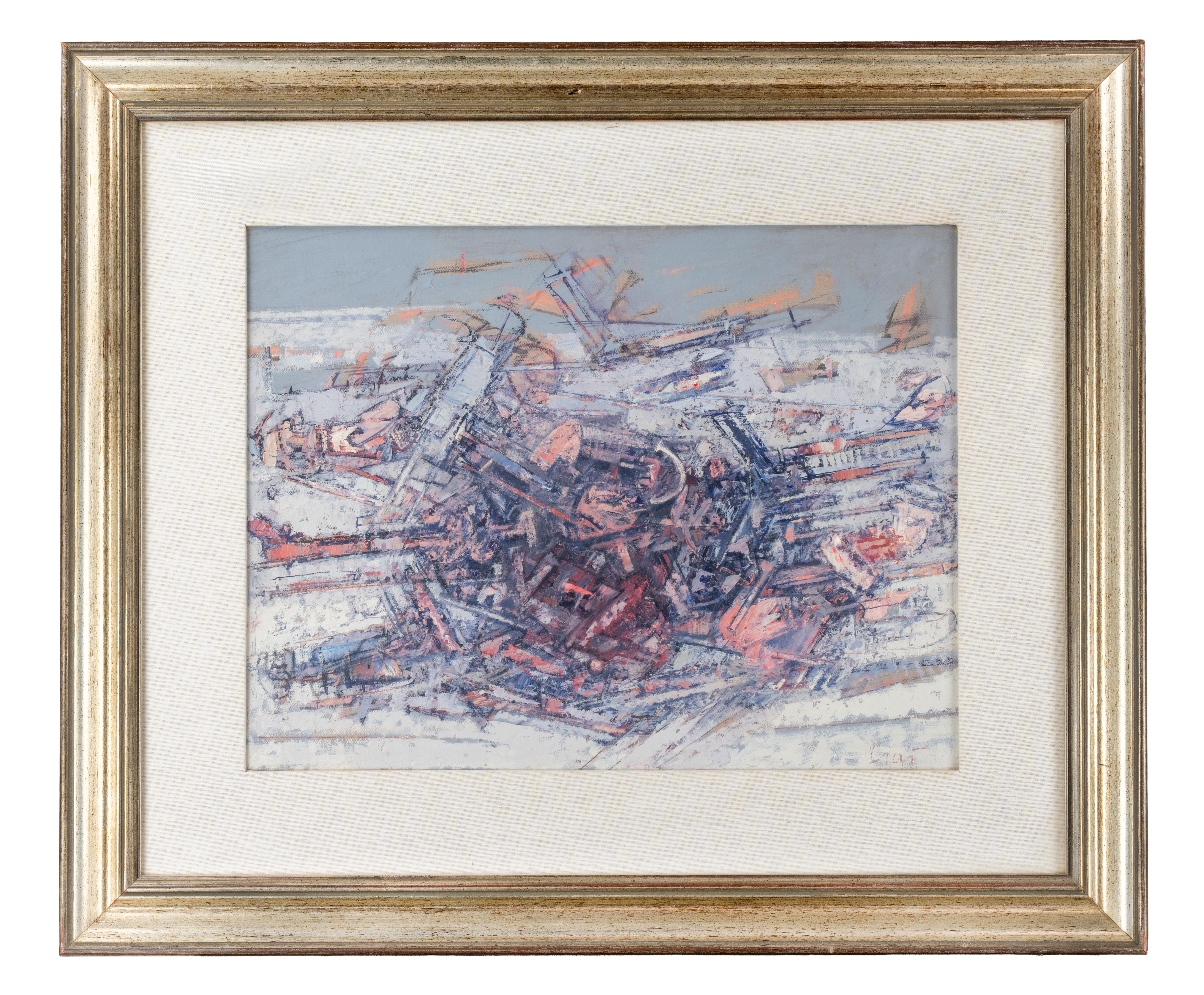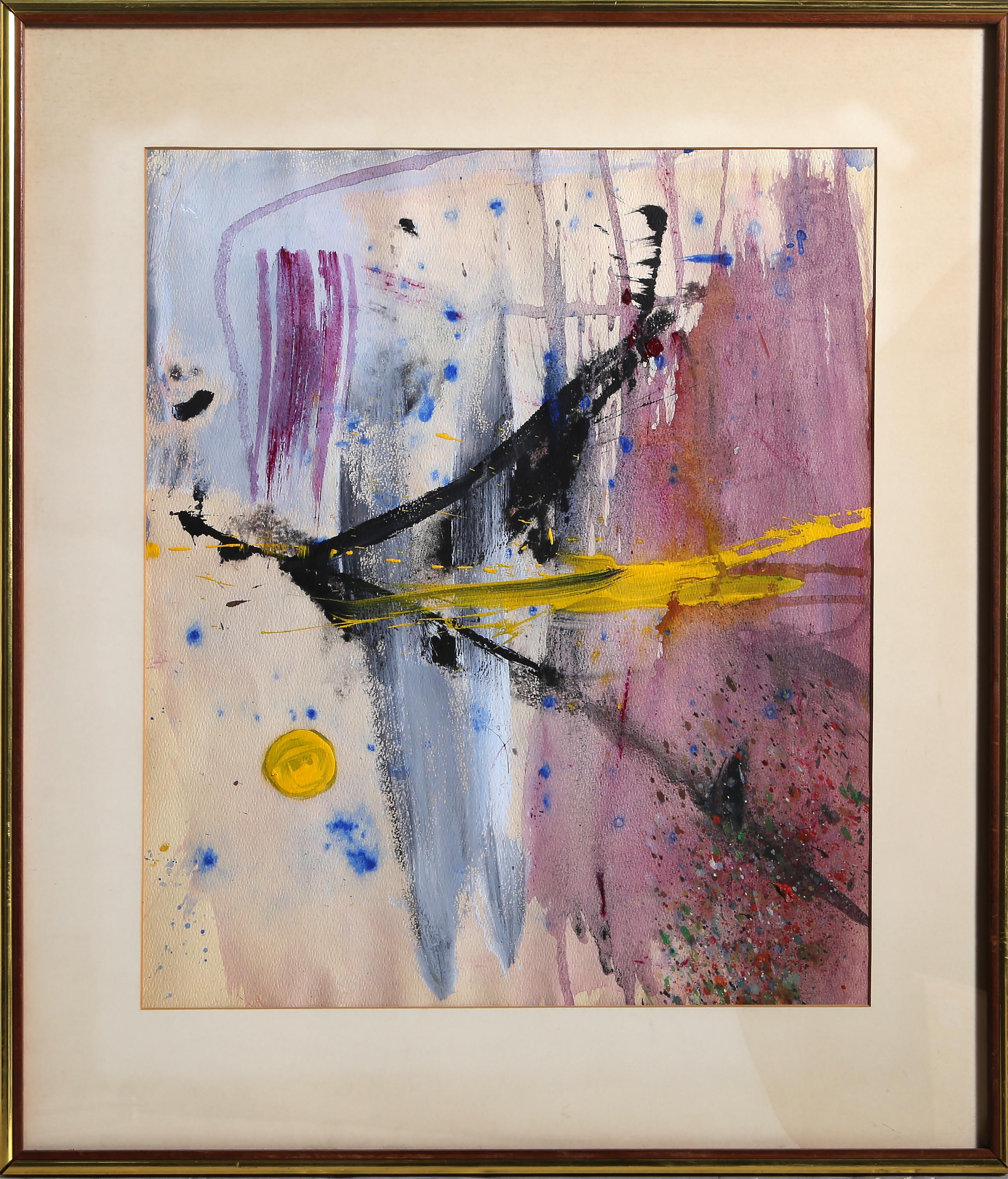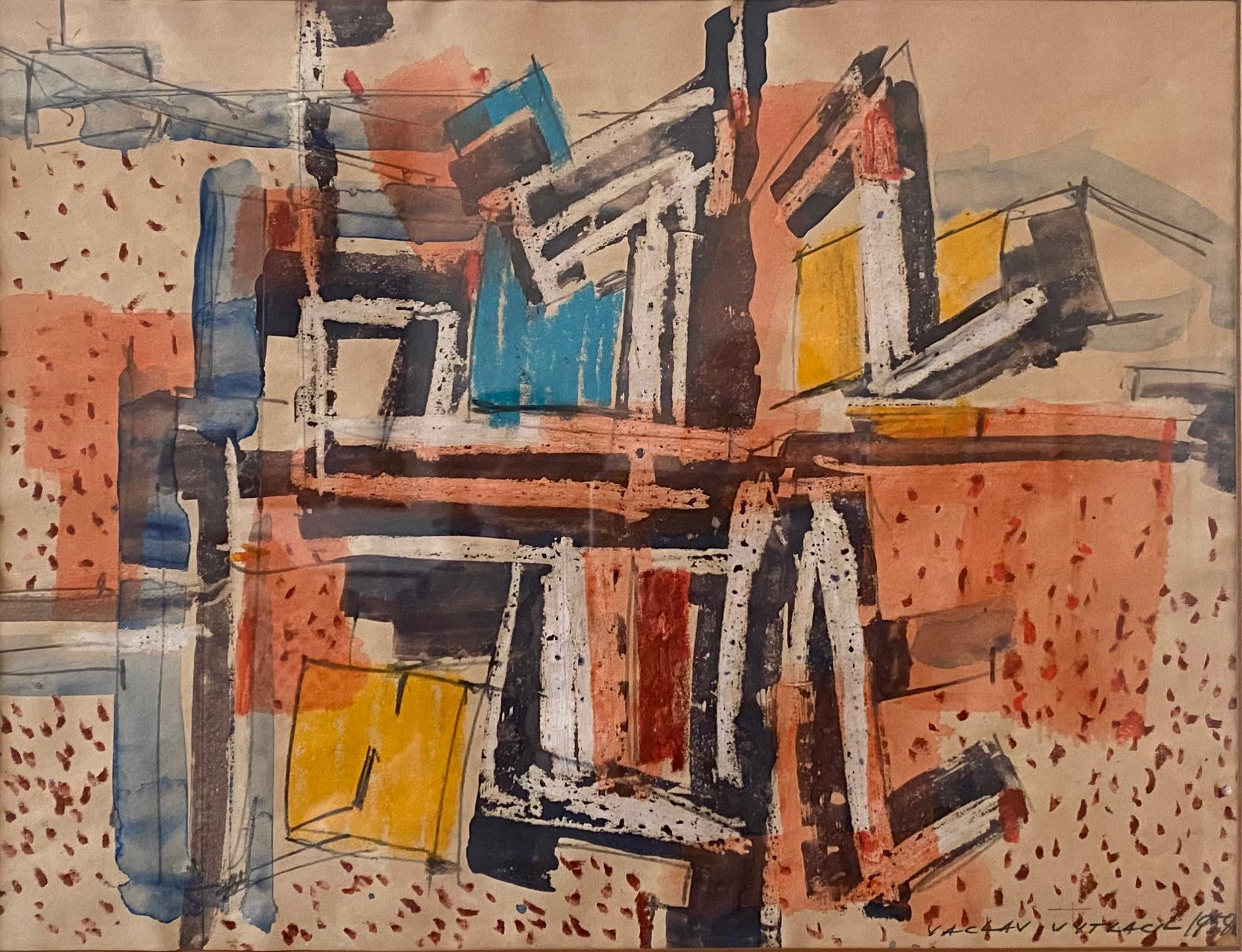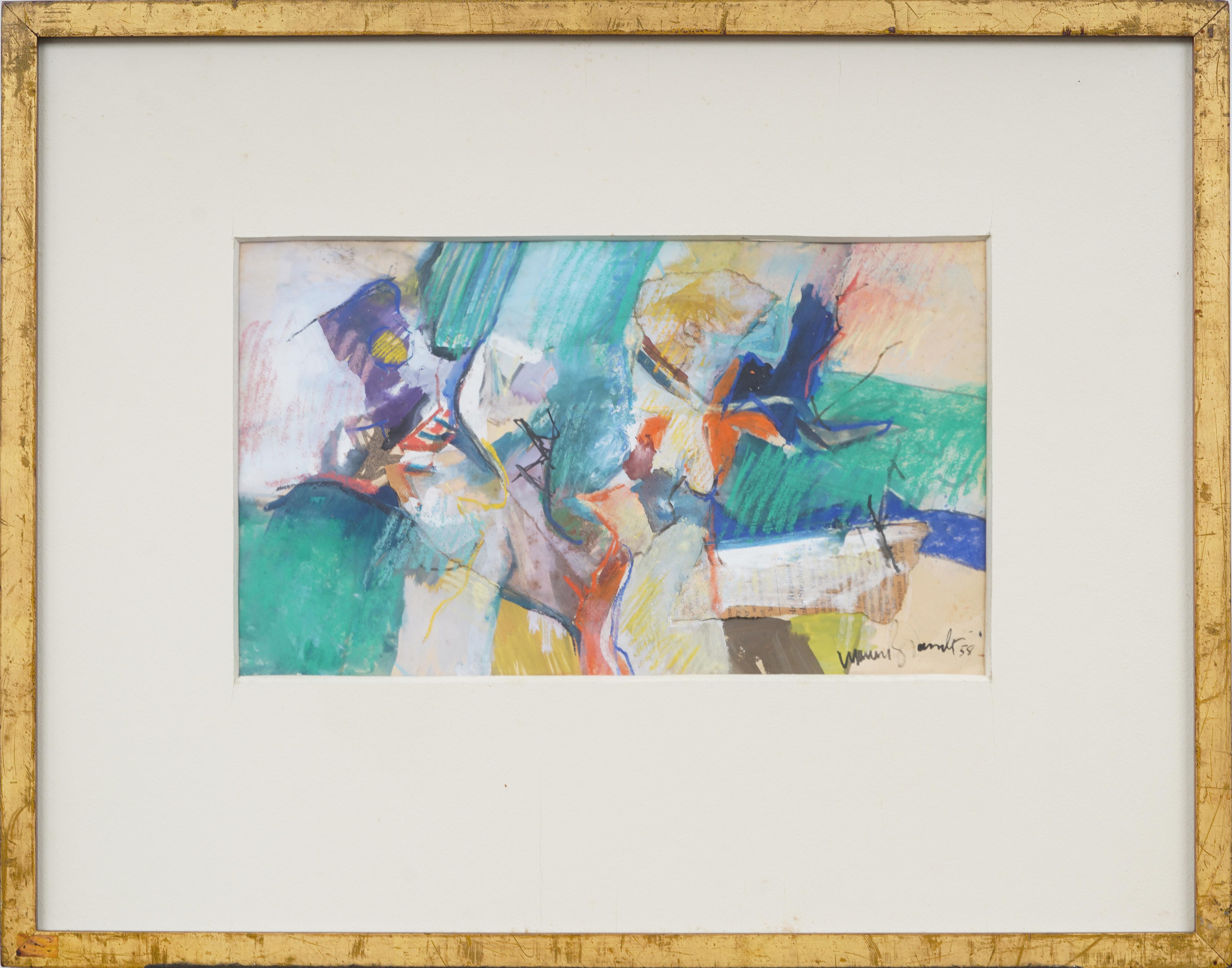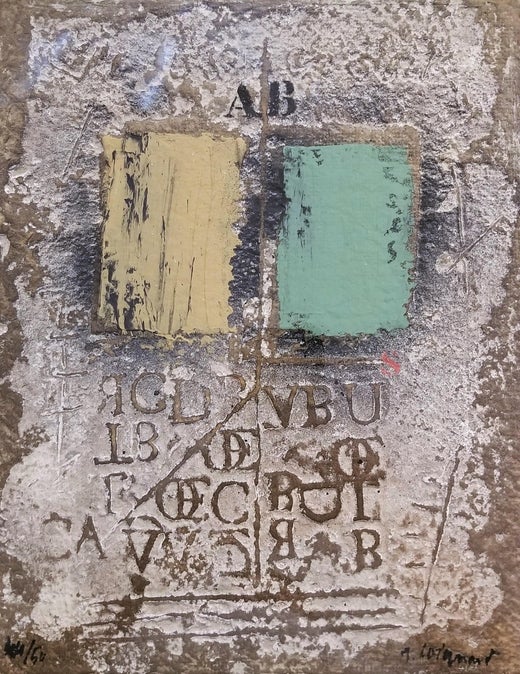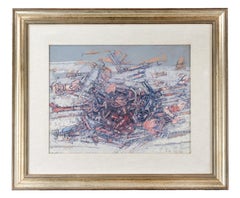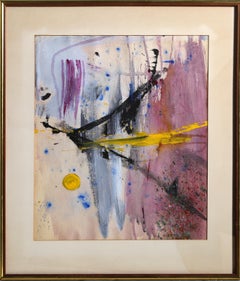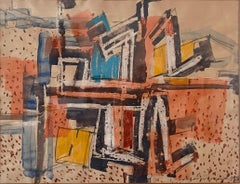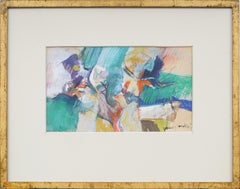Items Similar to Abstract composition JCI, 1960-65 - mixed media, 85x124 cm, framed
Want more images or videos?
Request additional images or videos from the seller
1 of 10
James CoignardAbstract composition JCI, 1960-65 - mixed media, 85x124 cm, framed1960-65
1960-65
$3,808.52
£2,833.69
€3,200
CA$5,335.69
A$5,855.87
CHF 3,020.04
MX$69,952.62
NOK 38,269.48
SEK 35,860.29
DKK 24,375.94
About the Item
Mixed media, gouache and paper, signed .
James Coignard est un peintre, graveur et sculpteur français, né le 15 septembre 1925 à Tours et mort le 7 mars 2008 à Mougins.
C’est au travers de la peinture et du dessin que James Coignard va développer sa pensée esthétique.
Au début de sa carrière, Coignard est assimilé aux réalistes de l’École de Paris. Très vite, il devient difficile d’arrêter son travail dans l’un des mouvements artistiques de cette seconde moitié du xxe siècle ; mais, au regard de son œuvre, il est clair que James Coignard appartient pleinement à son époque.
- Creator:James Coignard (1925-2008, French)
- Creation Year:1960-65
- Dimensions:Height: 33.47 in (85 cm)Width: 48.82 in (124 cm)Depth: 1.58 in (4 cm)
- Medium:
- Movement & Style:
- Period:
- Condition:
- Gallery Location:Nice, FR
- Reference Number:1stDibs: LU52831658203
James Coignard
James Coignard, painter, ceramist, sculptor and etcher, was born in Tours in 1925. At the age of 23 and after a brief career in the French administration, he discovers the landscapes of the French Riviera and decides to study at Arts décoratifs in Nice. Four years later, he quits his job at the administration to commit himself entirely to his artistic career. The encounter with Paul Hervieu in 1950 is decisive. His collaboration with gallery Hervieu made him known in artistic circles, nationally and internationally and then particularly in Scandinavia. At the beginning of his career, art critics label James Coignard as a member of Ecole de Paris. Soon, his painting and ceramic distances themselves from those of his colleagues and he goes it alone. At the beginning of the sixties, he starts to work with glass but the technical turning point occurs in 1968 when his friend Henri Goetz discovers a new etching technique, using carborundum. Etching then becomes central in his work. At the same time, his career takes off internationally. He travels a lot, especially to Sweden and USA where he lives during a few years. 1978, James Coignard participates in the creation of the etching studio Pasnic, with which he starts a long collaboration. During the eighties, he shares his time between Paris and the French Riviera and takes an interest in artist’s books and publishing issues. He exhibits now all over the world, and is acknowledged as one of the greatest painter-etchers of his time. Until his decease in 2008, James Coignard was a prolific painter, sculptor and etcher and leaves behind an immense work.
About the Seller
4.8
Vetted Professional Seller
Every seller passes strict standards for authenticity and reliability
Established in 1998
1stDibs seller since 2016
84 sales on 1stDibs
- ShippingRetrieving quote...Shipping from: Nice, France
- Return Policy
Authenticity Guarantee
In the unlikely event there’s an issue with an item’s authenticity, contact us within 1 year for a full refund. DetailsMoney-Back Guarantee
If your item is not as described, is damaged in transit, or does not arrive, contact us within 7 days for a full refund. Details24-Hour Cancellation
You have a 24-hour grace period in which to reconsider your purchase, with no questions asked.Vetted Professional Sellers
Our world-class sellers must adhere to strict standards for service and quality, maintaining the integrity of our listings.Price-Match Guarantee
If you find that a seller listed the same item for a lower price elsewhere, we’ll match it.Trusted Global Delivery
Our best-in-class carrier network provides specialized shipping options worldwide, including custom delivery.More From This Seller
View AllAbstract Composition PIII, 1992 - mixed media, 82x61 cm, framed
By Paolo Peterlé
Located in Nice, FR
Oil on plywood and mixed media, signed lower right
Category
Late 20th Century Abstract Abstract Paintings
Materials
Mixed Media
Abstract Composition XXI - N. European school, 1970-oil paint, 49x56 cm, framed
Located in Nice, FR
Oil on canvas, signed lower right. Framed. North Europe school.
Category
1970s Abstract Abstract Paintings
Materials
Oil
Abstract Composition AA1, 1968 - gouache and mixed media, 58x75 cm, framed
By Armand Avril
Located in Nice, FR
Gouache and paper, mixed media, Signed in the middle center.
Armand Avril, né à Lyon en 1926, est un peintre vivant à Cotignac dans le Var. Il est surtout connu pour les assemblages qu'il a réalisés à partir de 1968. D'origine modeste, cependant très tôt intéressé par l'art et les musées où le poussait son père, il s'essaie d'abord à la peinture. Cependant, Avril ne commence à trouver son véritable style qu'à l'âge de quarante-deux ans.
Enfant, il est un habitué des musées de Lyon qu’il fréquente sur les conseils de son père. Adulte, sa passion pour la collection l’incite à se nourrir des arts premiers et d’artistes comme Gaston Chaissac...
Category
1960s Abstract Abstract Drawings and Watercolors
Materials
Mixed Media
Abstract composition WL2, 1960-65 - oil paint, 49x58 cm, framed
By Leo Wesel
Located in Nice, FR
Oil on canvas, signed lower right.
Category
1960s Abstract Abstract Paintings
Materials
Oil
Abstract Composition Northern School, 1960-1965 - 59x49 cm, framed
Located in Nice, FR
Oil on canvas, signed lower right.
Northern school.
Category
Mid-20th Century Abstract Abstract Paintings
Materials
Oil
Abstract composition L1, 1940-50 - lithograph, 108x78 cm, framed
By André Lanskoy
Located in Nice, FR
Large lithograph, signed lower right, number: 43/50
André Lanskoy
He was born in Moscow. After 1905, the family moved to St. Petersburg, the capital in 1909. In 1918, he moved to Kie...
Category
Mid-20th Century Abstract Abstract Prints
Materials
Lithograph
You May Also Like
Abstract Composition - Mixed Media by Valeriano Ciai - 1960s
Located in Roma, IT
Mixed media on canvas realized by Valeriano Ciai (1928-2013) in 1960s.
Hand signed lower right.
Includes a contemporary wooden frame 57x68 cm-
Very good condition.
Category
1960s Contemporary Mixed Media
Materials
Mixed Media
Abstract Composition, Gouache and Watercolor by Stan Brodsky
By Stan Brodsky
Located in Long Island City, NY
Abstract Composition
Stan Brodsky
American (1925–2019)
Gouache and Watercolor on Paper
Size: 17 x 14.5 in. (43.18 x 36.83 cm)
Frame Size: 23 x 20.25 inches
Category
1980s Abstract Expressionist Mixed Media
Materials
Watercolor, Gouache
Abstract Composition
By Vaclav Vytlacil
Located in Los Angeles, CA
An abstract mixed media composition on paper.
Original frame and mat.
Signed and dated lower right.
He was born to Czechoslovakian parents in 1892 in New York City. Living in Chicago...
Category
1950s Abstract Expressionist Mixed Media
Materials
Mixed Media
Antique American Modernist Abstract Expressionist Signed Framed Painting
Located in Buffalo, NY
Signed and dated Warren Brandt '58, this dynamic mixed-media composition by American artist Warren Brandt (1918–2002) exemplifies mid-century abstraction with a vibrant use of color,...
Category
1950s Modern Abstract Paintings
Materials
Oil, Board
Jean Miotte - Abstract Composition - Original Signed Lithograph
By Jean Miotte
Located in Collonge Bellerive, Geneve, CH
Jean Miotte - Rare Original Signed Lithograph
Title: Abstract Composition
Dimensions: 76 x 56 cm
Edition: 98/150
Signed and Numbered in pencil
Jean Miotte, 1926 - 2016
Miotte came ...
Category
1970s Abstract Expressionist Abstract Prints
Materials
Aquatint
Untitled-055 mixed media abstraction by John Von Wicht
By John von Wicht
Located in Hudson, NY
What is exceptional about this artwork is that it has never been
matted, framed, glued, taped or exposed to light. It is one of a group of over 100 pieces personally selected by the...
Category
1960s Abstract Abstract Drawings and Watercolors
Materials
Paper, Mixed Media
